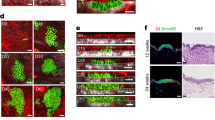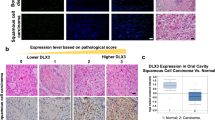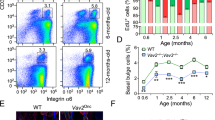Abstract
Constitutive Hedgehog (Hh) signaling underlies several human tumors1, including basal cell carcinoma (BCC) and basaloid follicular hamartoma in skin2,3. Intriguingly, superficial BCCs arise as de novo epithelial buds resembling embryonic hair germs4,5,6, collections of epidermal cells whose development is regulated by canonical Wnt/β-catenin signaling7,8. Similar to embryonic hair germs, human BCC buds showed increased levels of cytoplasmic and nuclear β-catenin and expressed early hair follicle lineage markers. We also detected canonical Wnt/β-catenin signaling in epithelial buds and hamartomas from mice expressing an oncogene, M2SMO9, leading to constitutive Hh signaling in skin. Conditional overexpression of the Wnt pathway antagonist Dkk1 in M2SMO-expressing mice potently inhibited epithelial bud and hamartoma development without affecting Hh signaling. Our findings uncover a hitherto unknown requirement for ligand-driven, canonical Wnt/β-catenin signaling for Hh pathway-driven tumorigenesis, identify a new pharmacological target for these neoplasms and establish the molecular basis for the well-known similarity between early superficial BCCs and embryonic hair germs.
This is a preview of subscription content, access via your institution
Access options
Subscribe to this journal
Receive 12 print issues and online access
$209.00 per year
only $17.42 per issue
Buy this article
- Purchase on SpringerLink
- Instant access to full article PDF
Prices may be subject to local taxes which are calculated during checkout




Similar content being viewed by others
References
Rubin, L.L. & de Sauvage, F.J. Targeting the Hedgehog pathway in cancer. Nat. Rev. Drug Discov. 5, 1026–1033 (2006).
Daya-Grosjean, L. & Couve-Privat, S. Sonic hedgehog signaling in basal cell carcinomas. Cancer Lett. 225, 181–192 (2005).
Grachtchouk, V. et al. The magnitude of hedgehog signaling activity defines skin tumor phenotype. EMBO J. 22, 2741–2751 (2003).
Lever, W.F. Pathogenesis of benign tumors of cutaneous appendages and of basal cell epithelioma. Arch. Dermatol. Syph. 57, 709–724 (1948).
Montgomery, H. Histogenesis of basal-cell epithelioma. Radiology 25, 8–23 (1935).
Sellheyer, K. & Krahl, D. Basal cell (trichoblastic) carcinoma common expression pattern for epithelial cell adhesion molecule links basal cell carcinoma to early follicular embryogenesis, secondary hair germ, and outer root sheath of the vellus hair follicle: a clue to the adnexal nature of basal cell carcinoma? J. Am. Acad. Dermatol. 58, 158–167 (2008).
Huelsken, J., Vogel, R., Erdmann, B., Cotsarelis, G. & Birchmeier, W. β-Catenin controls hair follicle morphogenesis and stem cell differentiation in the skin. Cell 105, 533–545 (2001).
Andl, T., Reddy, S.T., Gaddapara, T. & Millar, S.E. WNT signals are required for the initiation of hair follicle development. Dev. Cell 2, 643–653 (2002).
Xie, J. et al. Activating Smoothened mutations in sporadic basal-cell carcinoma. Nature 391, 90–92 (1998).
Fuchs, E. Skin stem cells: rising to the surface. J. Cell Biol. 180, 273–284 (2008).
St-Jacques, B. et al. Sonic hedgehog signaling is essential for hair development. Curr. Biol. 8, 1058–1068 (1998).
Chiang, C. et al. Essential role for sonic hedgehog during hair follicle morphogenesis. Dev. Biol. 205, 1–9 (1999).
Pasca di Magliano, M. et al. Common activation of canonical Wnt signaling in pancreatic adenocarcinoma. PLoS. ONE 2, e1155 (2007).
Taipale, J. & Beachy, P.A. The Hedgehog and Wnt signalling pathways in cancer. Nature 411, 349–354 (2001).
Mullor, J.L., Dahmane, N., Sun, T. & Altaba, A. Wnt signals are targets and mediators of Gli function. Curr. Biol. 11, 769–773 (2001).
Yamazaki, F., Aragane, Y., Kawada, A. & Tezuka, T. Immunohistochemical detection for nuclear β-catenin in sporadic basal cell carcinoma. Br. J. Dermatol. 145, 771–777 (2001).
El-Bahrawy, M., El-Masry, N., Alison, M., Poulsom, R. & Fallowfield, M. Expression of β-catenin in basal cell carcinoma. Br. J. Dermatol. 148, 964–970 (2003).
Saldanha, G., Ghura, V., Potter, L. & Fletcher, A. Nuclear β-catenin in basal cell carcinoma correlates with increased proliferation. Br. J. Dermatol. 151, 157–164 (2004).
Li, X., Deng, W., Lobo-Ruppert, S.M. & Ruppert, J.M. Gli1 acts through Snail and E-cadherin to promote nuclear signaling by β-catenin. Oncogene 26, 4489–4498 (2007).
Gat, U., DasGupta, R., Degenstein, L. & Fuchs, E. De novo hair follicle morphogenesis and hair tumors in mice expressing a truncated β-catenin in skin. Cell 95, 605–614 (1998).
Lo Celso, C., Prowse, D.M. & Watt, F.M. Transient activation of β-catenin signalling in adult mouse epidermis is sufficient to induce new hair follicles but continuous activation is required to maintain hair follicle tumours. Development 131, 1787–1799 (2004).
Ito, M. et al. Wnt-dependent de novo hair follicle regeneration in adult mouse skin after wounding. Nature 447, 316–320 (2007).
Jih, D.M. et al. Familial basaloid follicular hamartoma: lesional characterization and review of the literature. Am. J. Dermatopathol. 25, 130–137 (2003).
Oseroff, A.R. et al. Treatment of diffuse basal cell carcinomas and basaloid follicular hamartomas in nevoid basal cell carcinoma syndrome by wide-area 5-aminolevulinic acid photodynamic therapy. Arch. Dermatol. 141, 60–67 (2005).
Clevers, H. Wnt/β-catenin signaling in development and disease. Cell 127, 469–480 (2006).
Chu, E.Y. et al. Canonical WNT signaling promotes mammary placode development and is essential for initiation of mammary gland morphogenesis. Development 131, 4819–4829 (2004).
Callahan, C.A. et al. MIM/BEG4, a Sonic hedgehog-responsive gene that potentiates Gli-dependent transcription. Genes Dev. 18, 2724–2729 (2004).
Mao, B. et al. Kremen proteins are Dickkopf receptors that regulate Wnt/β-catenin signalling. Nature 417, 664–667 (2002).
Malanchi, I. et al. Cutaneous cancer stem cell maintenance is dependent on β-catenin signalling. Nature 452, 650–653 (2008).
Braun, K.M. et al. Manipulation of stem cell proliferation and lineage commitment: visualisation of label-retaining cells in wholemounts of mouse epidermis. Development 130, 5241–5255 (2003).
Acknowledgements
We thank Pierre Coulombe for providing K17 rabbit polyclonal antibody and Henry Sun for providing AE13 and AE15 antibodies; Eric Fearon and Deb Gumucio for constructive comments on the manuscript; and members of the Dlugosz lab for valuable input on this project. This work was supported by NIH grants R01-AR45973 and R01-CA87837 (A.A.D.), T32-HD007505 and T32-GM07863 (S.H.Y.), and R01-AR47709 and R01-DE015342 (S.E.M.). For production of transgenic mice we acknowledge members of the Transgenic Animal Model Core of the University of Michigan's Biomedical Research Core Facilities, funded in part by P30-CA46592 (University of Michigan Cancer Center Core support).
Author information
Authors and Affiliations
Contributions
Experiments were designed by S.H.Y. and A.A.D. Tissue harvests, whole-mount analysis, semiquantitative RT-PCR and immunoblotting were performed by S.H.Y. T.S.W. performed collection of human BCC samples. Immunohistochemistry and immunofluorescence staining were carried out by S.H.Y. and A.W. Genotyping was performed by S.H.Y., A.W., J.L., L.-J.S. and J.F. M2SMO-expressing mice were initially generated by V.G. Animal maintenance and breeding were performed by S.H.Y., A.W., J.L. and J.F. TRE-Dkk1 mice were provided by T.A. and S.E.M., and K5-rtTA mice were provided by A.B.G. T.A. and S.E.M. participated in study design and discussion of the results. The manuscript was written by S.H.Y., with draft revisions by A.A.D. and input from S.E.M. and T.A.
Corresponding author
Supplementary information
Supplementary Text and Figures
Supplementary Figure 1, Supplementary Table 1, Supplementary Note, Supplementary Methods (PDF 237 kb)
Rights and permissions
About this article
Cite this article
Hoseong Yang, S., Andl, T., Grachtchouk, V. et al. Pathological responses to oncogenic Hedgehog signaling in skin are dependent on canonical Wnt/β-catenin signaling. Nat Genet 40, 1130–1135 (2008). https://doi.org/10.1038/ng.192
Received:
Accepted:
Published:
Issue Date:
DOI: https://doi.org/10.1038/ng.192



